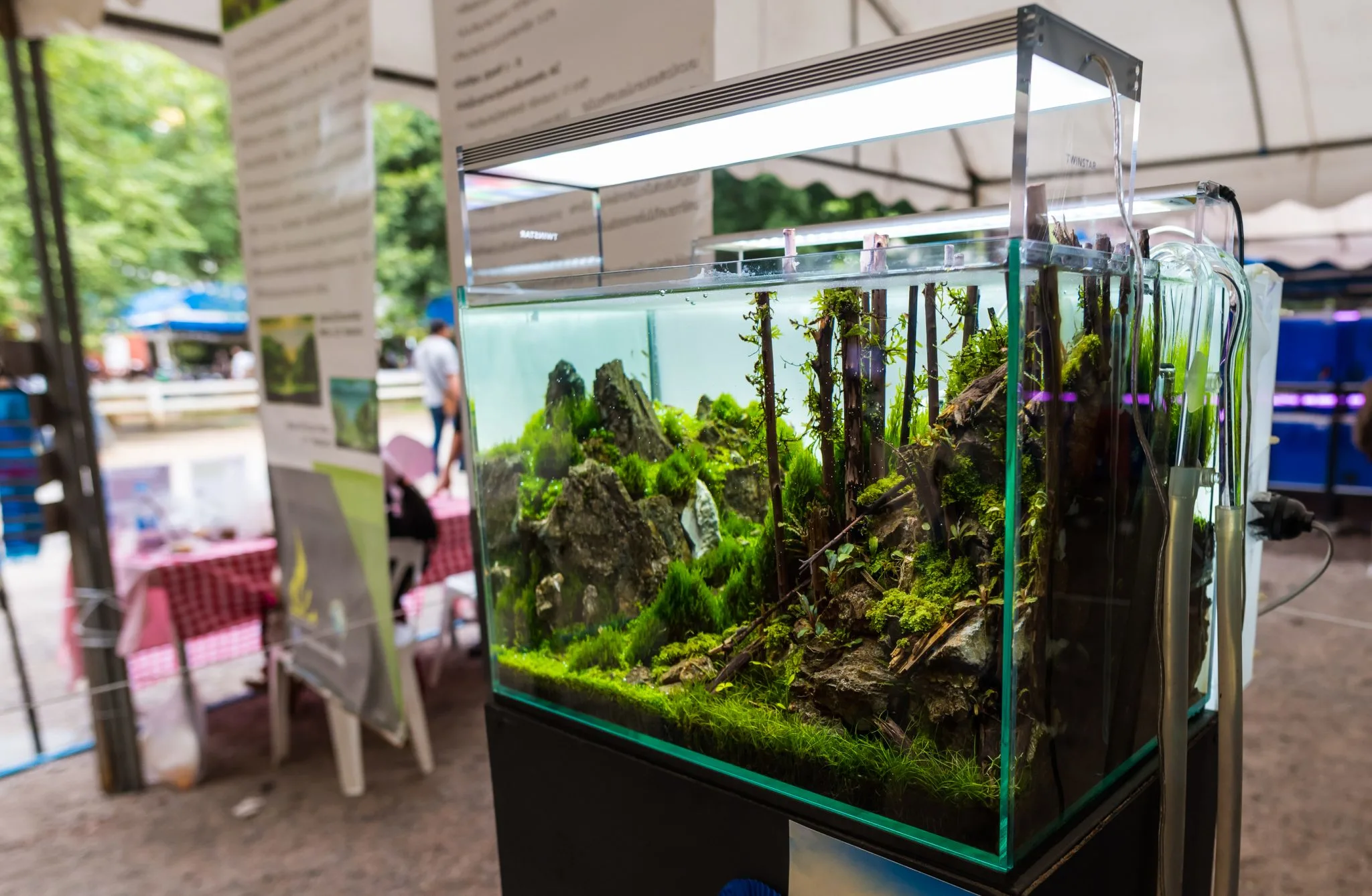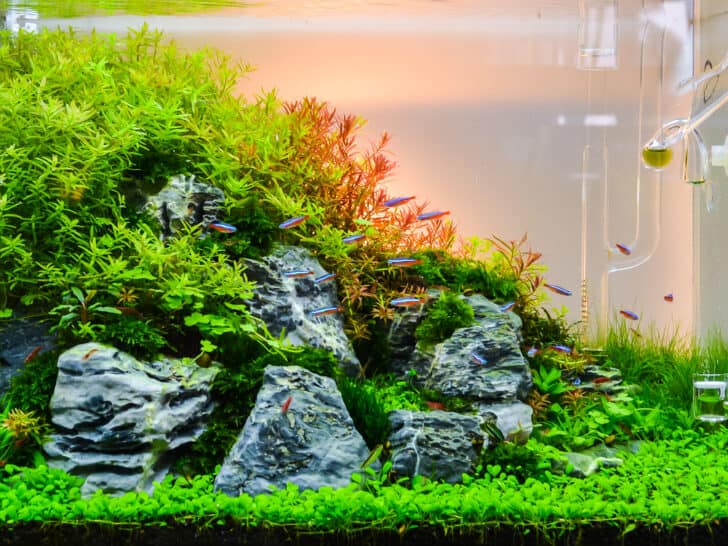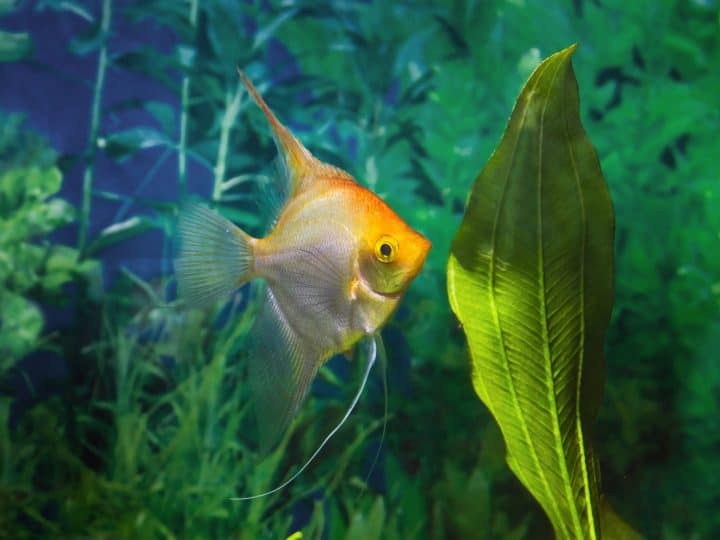Many aquarists doubt an average aquarium lifespan. Some folks talk about a 2-3 months, best-case scenario, others boast that their tanks are almost immortal. This straight-to-the-point article will prevent you from getting stuck in the common aquascape average lifespan brain-teaser.
Quick Answer
Your tank can last as long as the system is balanced. There’s no fixed timeframe or the moment your plants or livestock are destined to drop dead. Some setups experience a 2-3 month growth period and then stagnate due to poor planning and maintenance, successful ones can live almost forever.
You should read on to know some specific factors that affect the lifespan of your tank.
How Long Does an Aquascape Last?
On average, you can expect a lifespan of about six months for a planted tank. However, you can affect the lifespan of your aquarium plants in a positive way. If you mistreat your tank and its inhabitants, you may end up having rotting plants with drop-dead livestock. On the other side, if you stick to some basic rules described, you can be the owner of a thriving and brilliant aquarium.
Generally, aquarium lifespan depends on your set up, livestock/plants, and how you keep them. For example, suppose you clean your aquarium, deal with organic wastes, and avoid temperature fluctuations. In that case, you can expect both a three-month and 12-month lifespan for two different tanks, depending on the set up used and maintained.
Suppose you set your tank up correctly, for example, utilizing ADA aquasoil. In that case, you can expect about 30 months of active growth followed by a steady taper until you need to over-fertilize your plants to get a new traction phase.
What Does Planted Tank Lifespan Mean?
Generally, a tank’s lifespan is the moment at which organic waste dominates a tank, making its way into the aquarium’s nooks and crannies. As a result, your tank’s pH may suffer seriously. It may cause some unwanted consequences for your plants and livestock.
For an average aquarist, this moment lies in the range between the second and third years. According to my biologist friend, non-buffered tanks may get new substrate once a year or a year and a half.
You can keep your filters, pumps, hardscape, and even bio-media. Anything you can find within your tank can stay the same forever; the only thing that requires regular changes is your substrate. ‘
If your goal is to prolong the tank’s lifespan, you might want to replace substrate regulalry. No matter the aquatic plant species, remember that the right substrate can make a big difference. Moreover, different plants, live java moss, may require different plant substrates when compared to others, such as stem plants.
What Affects Your Aquascape’s Lifespan?
Once you know some essential factors affecting your tank’s lifespan, you can adjust your strategy to keep your tank fresh. Here is the list of fundamental factors that affect your tank’s lifespan.
- Glass cleanliness
- Trimming your plants
- Organic wastes
- Filtration system
- Decorative elements
- Regular water changes
- Health conditions of your livestock
- Aquarium water temperature
- CO2 level (Carbon Dioxide)
- Nutrients & Elements – such as potassium, phosphorus, nitrogen, magnesium, and other minerals.
Let’s talk about crucial steps that can prolong the lifespan of your tank.

How Can You Prolong Planted Tank Lifespan?
The upkeep of the aquascape is critical for the growth of plants, both in the background and foreground. When you keep your plants in their natural home, they generate more aquatic plants and develop rapidly, covering the whole surface of the tank.
An aquascape will cover the entire fish tank in a few months, giving it a unique appearance characterized by plant growth. You do not have to be a professional aquascaper or aquarist to participate. Once the plant has adapted to its new surroundings, it will expand in the other direction, sometimes breaking the water surface to find its way.
Even the movement of the plants outside of the liquid water looks great in the tank. To make the room appear spectacular, you may cover the whole tank with the Aquascape and surrounding elements.
Here are some suggestions you may need to follow to keep your Aquascape growing and sustainable in the long run.
Glass
If there is less water flow in the fish tank, algae might grow and coat the interior of the aquarium glass.
The glass will become coated with green algae over time, making the tank appear unclean. It would be beneficial if you cleaned the tank from the inside regularly, especially the aquarium glass.
Trimming Your Plants
If you see that any of your aquarium plants, whether anubias, swords, java fern, or otherwise, are growing enormously and wreaking havoc on the aesthetic, it is best to cut them as soon as possible to prevent it from spreading across the water.
It may obstruct the view and fill the tank with plant leaves. You must guarantee that the fish housed in the tank has enough area to swim.
Finally, the hard work you put into Aquascape is for the fish you put in the tank. If your Aquascaping cannot create the natural habitat your fish would love, your efforts will be vain.
Light Intensity
Make sure to provide your plants with aquarium light. Plants can’t survive without light, but keep in mind that too much light can be a bad thing as well. Aquarium plants generally need around 8 hours of light per day to thrive.
Organic Particles
During its development, the plant would generate organic waste—for example, leaves, broken branches, etc.
Remove the waste from the aquarium before it begins to decompose. In contrast to a natural aquarium, they can collect and cause difficulties.
Cleaning the Filter
To keep the water clean, clean your filter regularly. Algae colonize the filter and make it their home. Algae growth can be very detrimental for an aquarium. As the waste product is drawn into the filter, the algae multiply rapidly, filling your filter with algae of varying sizes.
Clean Decorative Items
An Aquascape typically takes one to one and a half months to fully develop. The tank’s decorations would serve as a home for algae, viruses, and bacteria during this time.
For example, the rock utilized in the Aquascape would naturally attract bacteria, and over time, they would create waste, which would then float in the water.
Cleaning the decoratives regularly will maintain your water clean and oxygen-rich.
Regular Water Change
Water changes are a standard routine that every aquarium owner should follow to maintain the water clean and breathable for the live species.
The water is purified by the fresh groundwater, the flowing river bodies, or the lake. The nutritious ingredient is present in clean water, which also has a high oxygen content. The stagnant water in the tank will deplete the oxygen over time as aquatic plants and fish consume it.
It’s advised that you make a 50 percent water change once a week to keep your Aquascape in good condition. As a result, frequent water changes are required.
Remember that live aquarium plants that perform photosynthesis increase tank oxygen levels on a regular basis, something that beginners should know. For anybody starting an aquarium hobby, remember that the general hardness of the water must also be considered, something that hardcore enthusiasts know all too well.
Regular Livestock Check-ups
Keep an eye on the animals to make sure they’re having a good time in the aquarium. Some plants found in water are toxic to some fish species. Fish become ill when they come into touch with or ingest the plants.
If you notice the fish behaving abnormally, it is possible that the fish is having difficulty breathing or that a chemical released by the plant makes them feel uncomfortable. Remove the fish from the aquarium immediately and place them in a separate tank until they recover from their sickness.
Temperature
Temperature control is critical for both fish and aquatic vegetation. As the temperature rises, the oxygen content in the water decreases, endangering the cattle.
Use aquarium temperature management devices to keep track of the water temperature.
If you have a heater for managing the temperature in the aquarium, make sure it is operating correctly.
The chilly temperature would make the fish’s surroundings unbreathable, and your fish would perish. Using a high-quality LED light can also help to minimize tank temperature.
CO2 and Lack of Nutrients
Ascertain that the CO2 level in the water is within control. Increased CO2 levels would cause the fish to become unwell. When the CO2 level in the water rises, aquascaping likewise grows slowly.
When a plant does not receive enough nourishment, it develops nutritional deficiencies. The development of aquatic vegetation will slow down.
The growth slows, and some of the plants rot prematurely. It would be beneficial if you could manage the nutritious qualities of the water by often replacing it with fresh water.
When your Aquascape starts to grow, you should change the water frequently to give the plant enough time to thrive. CO2 infusion is sometimes required. Don’t forget to monitor water hardness too!
Afterword
Even though many aquarists talk about a 2-3 year drop-dead life cycle for a planted tank, the tank’s end of the life is technically never though, since good maintenance or a good ecosystem in the tank can keep it going almost forever. If you stick to the essential points mentioned above, you won’t have any issues related to your aquarium’s lifespan.


